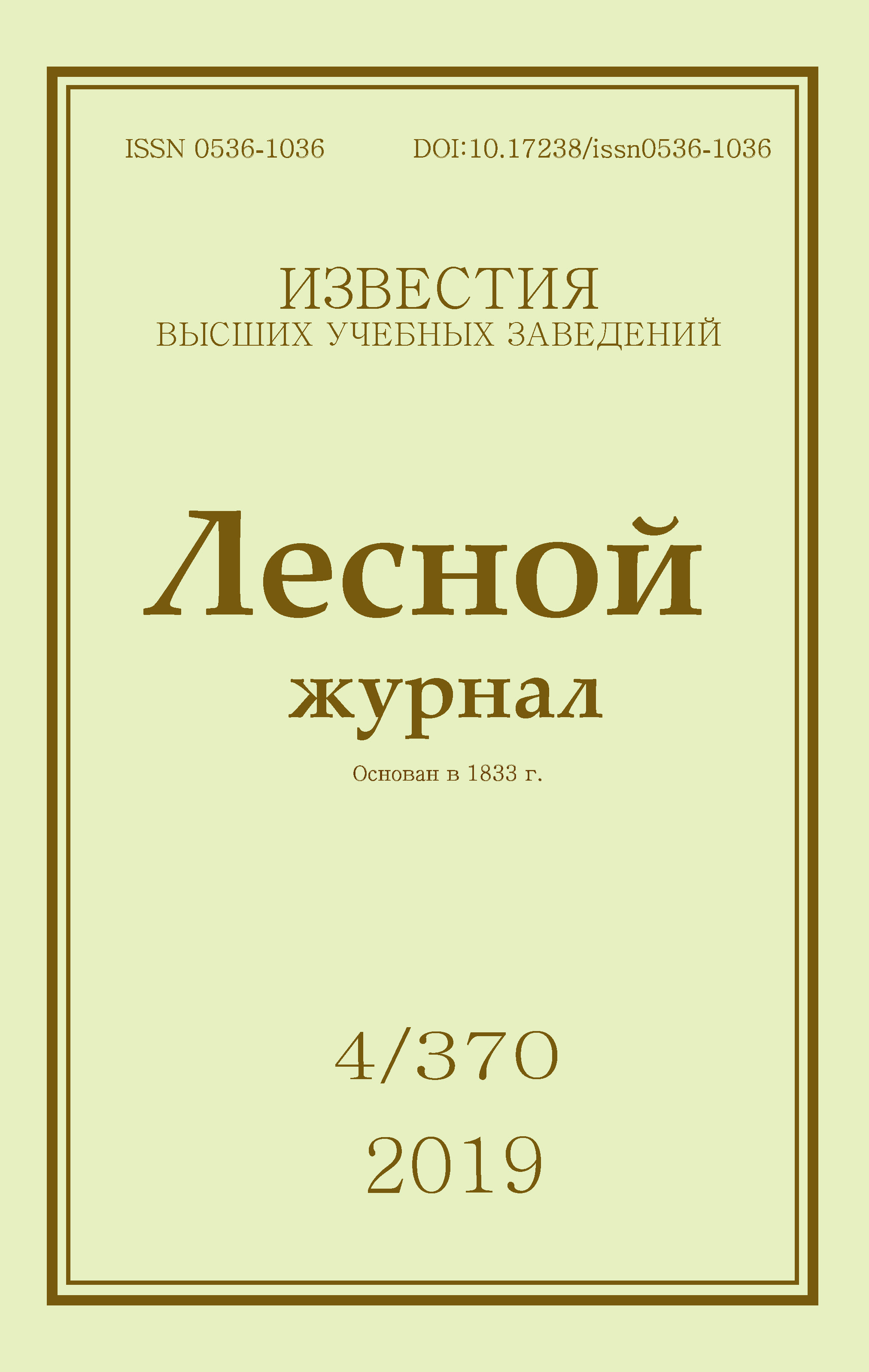Influence of Coagulation Treatment on the Efficiency of Lignin Containing Wastewater Purification
DOI:
https://doi.org/10.17238/issn0536-1036.2019.4.159Keywords:
coagulation, coagulant, wastewater treatment, planned experiment, pulp and paper industryAbstract
An effective way to remove lignin substances from the effluents of pulp and paper mills is the coagulants treatment. According to the local treatment scheme, lignin-containing waste water is treated separately, i.e. before mixing with the general flow of the enterprise. To study the efficiency of the process of coagulation of lignin by aluminum- and iron-containing reagents, it is proposed to apply the response surface methodology, namely – the rotatable central composition plan of the second order for three factors. The object of research was model water containing
400 mg/l sulfate lignin. The effect of coagulant dosage, pH and duration of wastewater treatment on the degree of lignin and chromaticity purification was studied. All the derived models were verified to be adequate. Response surfaces were constructed to demonstrate the effect of regime parameters on the output characteristics. It was found that pH and coagulant dosage have a significant effect on the efficiency of lignin removal. The optimal pH and dosage intervals for the studied reagents were determined: aluminum sulfate and oxychloride, aluminum alum and iron sulfate (III). The duration of coagulant treatment in the range from 1 to 4 minutes has no effect on the degree of purification. The best results were obtained using aluminum oxychloride: lignin and chromaticity purification efficiency exceeded 90 % under the following optimal conditions: pH 6,7...7,0, dosage – 50...55 mg Al2O3/l.
For citation: Sedova E.L., Burkova S.A., Vorontsov K.B. Influence of Coagulation Treatment on the Efficiency of Lignin Containing Wastewater Purification. Lesnoy Zhurnal [Forestry Journal], 2019, no. 4, pp.159–167. DOI: 10.17238/issn0536-1036.2019.4.159
*The article was published in the framework of implementation the development program of scientific journals in 2019.
Downloads
References
Андреев А.И., Селянина С.Б., Богданович Н.И. Сорбционные свойства лиственных и хвойных сульфатных лигнинов // Химия растительного сырья. 2012. №. 2. С. 33–39.
Байбородин А.М., Воронцов К.Б., Богданович Н.И. Коагуляционная очистка сильнозагрязненного стока ДПЦ-3 ОАО «Архангельский ЦБК» // Лесн. журн. 2012. № 4. (Изв. высш. учеб. заведений).
Байбородин А.М., Воронцов К.Б., Богданович Н.И. Разработка системы локальной очистки сильнозагрязненных сточных вод целлюлозно-бумажных предприятий // Вода: химия и экология. 2011. № 8. С. 16–21.
Богданович Н.И. и др. Планирование эксперимента в примерах и расчетах // Архангельск: Изд-во САФУ, 2010. 126 с.
Варакин Е.А. и др. Влияние сточных вод производства целлюлозы на окислительную способность микроорганизмов очистных сооружений // Вестн. Казан. технол. ун-та. 2015. Т. 18, № 7. С. 277–280.
Гетманцев С.В., Нечаев И.А., Гандурина Л.В. Очистка промышленных сточных вод коагулянтами и флокулянтами. М.: Изд-во Ассоциации строительных вузов, 2008. 272 с.
Дягилева А.Б., Чернобережский Ю.М. Коллоидно-химические аспекты очистки сточных вод от примесей лигнинов. Ч. 2 // Целлюлоза. Бумага. Картон. 2009. № 8. С. 74–78.
Линевич С.Н., Гетманцев С.В. Коагуляционный метод водообработки. М.: Наука, 2007.
Личутина Т.Ф., Боголицын К.Г., Гусакова М.А. Экологическая оценка деятельности предприятий целлюлозно-бумажной промышленности. Перспективные направления утилизации отходов // Рос. хим. журн. 2011. Т. 55, № 1. С. 101–107.
Смирнова А.И., Дягилева А.Б. Механизм формирования органоминеральных структур на основе сульфатного лигнина и алюмосодержащих компонентов // Лесн. журн. 2011. № 6. С. 112–118. (Изв. высш. учеб. заведений).
Хабаров Ю.Г. Методы определения лигнинов // Лесн. журн. 2004. № 3. С. 86–102. (Изв. высш. учеб. заведений).
Штамм Е.В. и др. Природа токсического воздействия сточных вод предприятий целлюлозно-бумажного производства на водные экосистемы // Химическая физика. 2015. Т. 34, № 6. С. 22. DOI: 10.7868/S0207401X15060072
Birjandi N., Younesi H., Bahramifar N. Treatment of Wastewater Effluents From Paper-recycling Plants by Coagulation Process and Otimization of Treatment Conditions With Response Surface Methodology. Applied Water Science, 2016, vol. 6, no.4. pp. 339–348.
Chernoberezhskii Y.M. et al. Recovery of Kraft Lignin From Aqueous Solutions with Oxotitanium Sulfate, Aluminum Sulfate, and Their Mixture. Russian journal of applied chemistry, 2002, vol. 75, no.10, pp. 1696–1699.
Irfan M. et al. The Removal of COD, TSS and Colour of Black Liquor by Coagulation–Flocculation Process at Optimized pH, Settling and Dosing Rate. Arabian Journal of Chemistry, 2017, vol. 10, pp. S2307–S2318.
Kamali M., Khodaparast Z. Review on Recent Developments on Pulp and Paper Mill Wastewater Treatment. Ecotoxicology and Environmental Safety, 2015, vol. 114, pp. 326–342.
Lindholm-Lehto P.C. et al. Refractory Organic Pollutants and Toxicity in Pulp and Paper Mill Wastewaters. Environmental Science and Pollution Research, 2015, vol. 22, no. 9, pp. 6473–6499.
Tir M., Moulai-Mostefa N. Optimization of Oil Removal From Oily Wastewater by Electrocoagulation Using Response Surface Method. Journal Of Hazardous Materials, 2008, vol. 158, no.1, pp. 107–115.
Trinh T.K., Kang L.S. Application of Response Surface Method as an Experimental Design to Optimize Coagulation Tests. Environmental Engineering Research, 2010, vol. 15, no. 2, pp. 63–70.
Trinh T.K., Kang L.S. Response Surface Methodological Approach to Optimize the Coagulation–Flocculation Process in Drinking Water Treatment. Chemical Engineering Research And Design, 2011, vol. 89, no. 7, pp. 1126–1135.
Поступила 19.06.19







